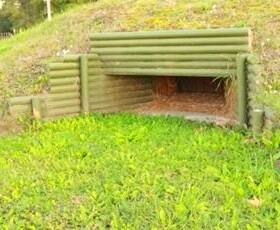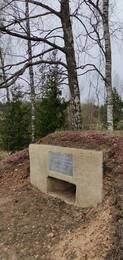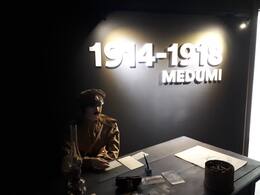Log pillbox
I World War I, II World War II, IV Soviet Occupation
A log pillbox (Latvian: dzots, derived from an acronym for the Russian term "Дзот" Деревоземляная огневая точка) is a field fortification structure built of logs and boards, with an embankment of earth.
A pillbox required more construction resources than a log pillbox.
The term ‘log pillbox’ was sometimes used to refer to a shelter immersed into the ground in a trench system (also, a bunker or blindage).
More information sources
https://encyclopedia2.thefreedictionary.com/Log+Pillbox
Related timeline
Related objects
Kundera pillbox
The memorial of the fallen officer of the 8th Estonian Rifle Corps of the Red Army, Jakob Kundera (deleted), is located at the cemetery 200 metres south-west of the Blidene-Remte road and the Riga-Liepaja railway junction.
On 17 March 1945, the last attempt of the Red Army's offensive in Kurzeme began. The task of the 7th Estonian Rifle Division of the Estonian 8th Rifle Corps was to reach the Riga-Liepaja railway line west of Blidene station and to secure the attack of the Mechanised Corps of the 3rd Guards in the direction of Gaiki. By the evening of 17 March, the 354th Rifle Regiment reached the railway south of Kaulači Manor through the forest and continued its attacks in a north-westerly direction. As the attacks of the 130th Latvian Rifle Corps towards Pilsblidene Manor were not so successful, the Estonian 300th Rifle Regiment was tasked to attack westwards and south-westwards on the night of 18 March to cross the railway from the north to capture Blidene station.
In the vicinity of Blīdene station, already in the spring of 1940, the Latvian army had built temporary barracks and warehouses, which were designated as "Barracks". During 1945, the German army built several underground shelters (bunkers) in the vicinity of the station, where soldiers could live during the winter. There were no fortifications, driven or given, and it is most likely that Lieutenant Jakob Kunder fell during close combat at one of the bunkers.
Immediately after the battle, Jakob Kunder was buried in what is now Pilsblidene Cemetery, and later reburied in the Tuški Brethren Cemetery.
Today, a symbolic Soviet reproduction of a reinforced concrete machine-gun embrasure with a commemorative plaque can be seen.
First World War Museum
The fiercest battles of the First World War in Latvia took place near Daugavpils in August and October 1915, in the highlands of Ilūkste and Medumi. The Germans tried to break through to Daugavpils, but the Russians – to push them back. Both sides were unsuccessful and began to build trenches, creating in depth defence positions consisting of three lines.
The First World War Museum in Medumi is dedicated to these battles. The first part of the exhibition presents the history of the vicinity of Medumi, providing testimonies that bear evidence that Medumi was a well-populated and developed area before the war. Part 2 focuses on the events of the First World War in Europe and Latvia. Here, you can learn about the lives of soldiers and the innovations that emerged during the war, as well as examine the weapons used by the German and Russian armies. In the third hall of the exhibition, visitors can put themselves in the shoes of a soldier by experiencing bunker life. In this hall, a replica of a Russian bunker has been created – a fragment of a trench with a small shelter, elements of a battlefield and dummies of soldiers. Since the wooden bunkers of the Russian Army did not survive, they have been reconstructed at the museum, while the concrete bunkers of the German Army can be seen by visiting the International route of WWI Bunkers. The hall, with the imitation of a shelter, audio and video equipment, creates an authentic atmosphere of the battlefield.









